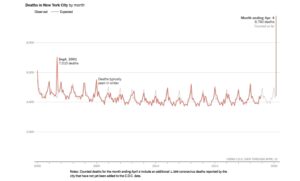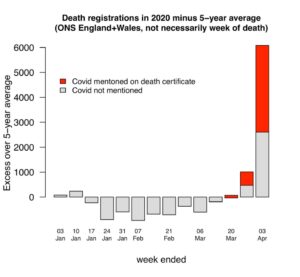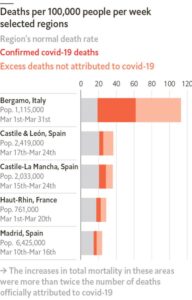A: Yes, very likely. Since thus far most COVID-19 deaths are only recorded as such if the person has tested positive prior to death, deaths at home or in nursing/care homes and even in hospitals may not be counted.
In New York City this week, officials released additional data on “presumptive” cases due to their symptoms and medical histories. This added an additional 3,700 people presumed to have died from COVID-19 but never tested (more at this link).
Demographers have some additional tricks for trying to estimate deaths in this situation where cause of death is unreliable, looking for total “excess deaths” above and beyond what has been experienced during a similar period in the past (see photo below). From Italy and Spain to the UK and New York City, it seems that overall deaths (which are much easier to count) have indeed been much higher than expected compared to the average of the same period over the last several years. This also means that it is unlikely that COVID-19 is killing only people with underlying conditions who were likely to die soon anyway.
One thing that will take time to figure out is how much of this “excess” mortality is directly due to COVID-19 versus an overwhelmed health care system or people reluctant to seek out care for other conditions such as heart attacks due to fear of the virus. We expect mortality from some causes such as traffic accidents to fall during lockdown, creating countervailing forces that may also disguise the true burden of COVID-19 mortality.
So stay tuned, demographers are on the case. The more quickly daily and weekly data on COVID and all-cause deaths are made available, the more quickly we can get the best estimates of COVID-19 mortality and what measures have been most effective at reducing this.





